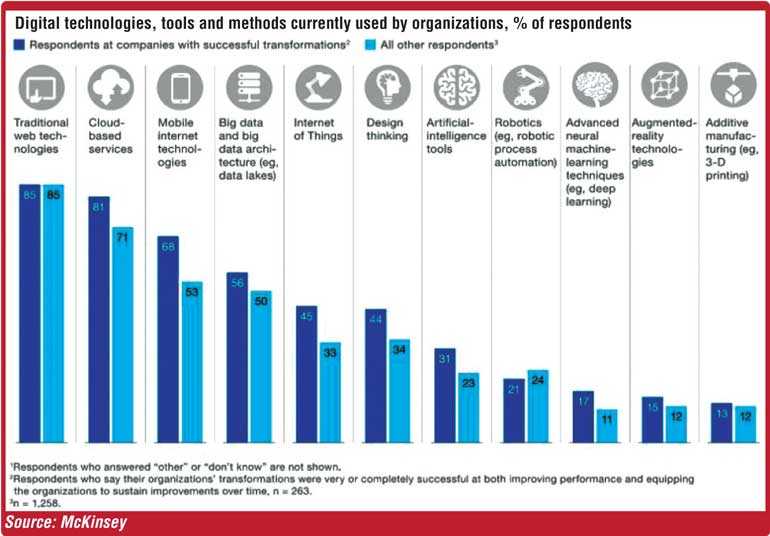Thursday Nov 27, 2025
Thursday Nov 27, 2025
Thursday, 30 January 2020 00:39 - - {{hitsCtrl.values.hits}}

As with any new concept, there are multiple ways of going about executing a digital transformation in an organisation, and nearly all of them focus on clear goals, the right financial and time commitment, people-centricity, and embracing agility. But how do know where to begin?
By The Digital Nomad
Over the past several years we have seen so many references to digitalisation, and digital transformation, that it’s become second nature to talk about it at any meeting. I’ll even go to mention it over 18 times in this piece alone. But what does it mean and how do we go about it?
Digitalisation is the use of digital technologies to change a business model and provide new revenue and value-producing opportunities, it is the process of moving to a digital business. (Gartner)
Despite the universal hype, very few organisations take up digitalisation as a core element of their annual, 3Y, or 5Y strategies. Instead digitalisation is drawn up as a separate silo, where it might be outsourced to a third-party developer, masqueraded as a token app (e.g. the ever-popular loyalty app), or completely bluffed over with some digital marketing project (not to say that they aren’t important).
Whilst some, or all, of these could count as elements of digitalisation, a comprehensive digital strategy they do not make. Granted, there are numerous factors into why organisations won’t quickly embrace digitalisation, with standard set of reasons ranging from:
For all the reluctance we see locally, at a global stage there are numerous giants that have been implementing digitalisation as part of their core strategies for the better part of a decade. Whilst the most prominent are the technology giants; Alphabet, Amazon, Netflix, Apple, we see names from more ‘traditional industries’ such as Marriott Hotels, Dow, Pfizer, and 3M. Granted the latter is a textbook case of how innovation can be implemented successfully over multiple decades.
One common denominator amongst them is the strength in numbers; the most successful digital transformations come from organisations that deploy multiple projects. The positive feedback from these successes also drives the uptake in more complex technologies such as AR.
As with any new concept, there are multiple ways of going about executing a digital transformation in an organisation, and nearly all of them focus on clear goals, the right financial and time commitment, people-centricity, and embracing agility. But how do know where to begin?
One method of going about how to digitalise can be derived through introspection at an organisation level, whereby looking at internal processes can help understand what needs to be done to perform better externally.
1. Understanding how digitalisation can optimise the organisation
This might be the most critical element, as internal processes can dictate how well (or poorly) an organisation performs within their industries; who they approach, how they market and sell, and how quick they are. Therefore, optimising these operations can go a long way in making any organisation future-ready (sometimes even present-ready).
Despite the universal hype, very few organisations take up digitalisation as a core element of their annual, 3Y, or 5Y strategies
A fundamental element that is often overlooked is scalability with newly digitalised business processes. It’s not enough to just improve the core function of a process, it’s crucial to see how it can integrate (e.g. availability of APIs) with both existing and new operations.
Numerous times have new initiatives sweltered in development hell as dev teams struggled to integrate core elements (e.g. invoicing) with existing organisation practices. Often the existing practices and cultures win, crippling the initial outcome of the whole initiative, and throwing a cloud of doubt over the whole concept of digitalisation.

2. Identifying how digitalisation can enable and enhance existing revenue streams
This goes hand-in-hand with the first point, as digitalisation can be looked at as both cost-cutting and revenue-generating drivers. Once the digital-readiness of an organisation has reached a confident level, it can start leveraging various technologies to either increase or further consolidate its market share.
One useful example is the impact that digitalisation has brought to the banking industry. Online banking has drastically changed the way banks operate; far greater reach through online services, whilst reducing the number of brick-and-mortar branches.
However that reach does come with inherent digital risk. Data security begins to take a much more key role in the decision making process for new digital ventures when dealing with customer related data, sometimes even deterring the most capable institutions from fully delving into digitalisation, and with good reason.
Nevertheless, this can be overcome with the right expertise, the right goals, and right financial commitments.
3. Identifying how digitalisation can create new revenue streams for completely new markets
Investing in a venture that deals with an industry that an organisation has no prior expertise with, is risky business. However, when executed right, the benefits can sometimes redefine the organisation as a whole.
A common household name but often overlooked story is of how iTunes helped 25-year-old (in 2001) Apple to transition from selling bright, colourful desktops, to dominating the media industry, with a digital jukebox software. Through it came a myriad of services, not just for storing music on iPods and iPhones, but for media management, a digital marketplace (the App Store), a eventually phasing into a streaming service (Apple Music) and even production studio (Apple TV).

It may be commonplace to think that every organisation undergoes digitalisation, from one to three, but it may not be the case. As with corporate innovation, the most successful companies tackle it at all stages; improving internal processes, whilst developing new sales channels, and even perhaps incubating a few new long term digital start-ups. Some start off with Option 3; the likes of Uber, Tesla, AirBnB taking existing technologies and implementing revolutionary ideas in an extremely short space of time (with varying levels of success).
It ultimately depends on the industry that the organisation tends to play in, technology companies will spend less time on Option 1 and more on 2 or 3, whereas manufacturing and pharmaceuticals organisations will spent more time on refining their internal processes.
The question is no longer what can we do with digital, but how can we achieve targets X and Y through digitalisation?
The concept of digitalisation goes well and beyond apps or sensors or websites. It is weaved in to the very fabric of our society such that, living without some of its elements seems almost impossible. So as we enter a new decade, I’m sure there are countless organisations that will commit to leveraging digitalisation or executing some form of a digital transformation. How many of us are truly looking at digital, not as a separate business, but as the new norm of doing business?
(The writer comes from the tech industry and can be reached at [email protected].)